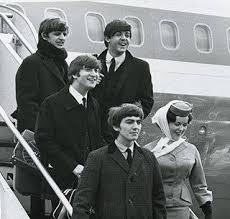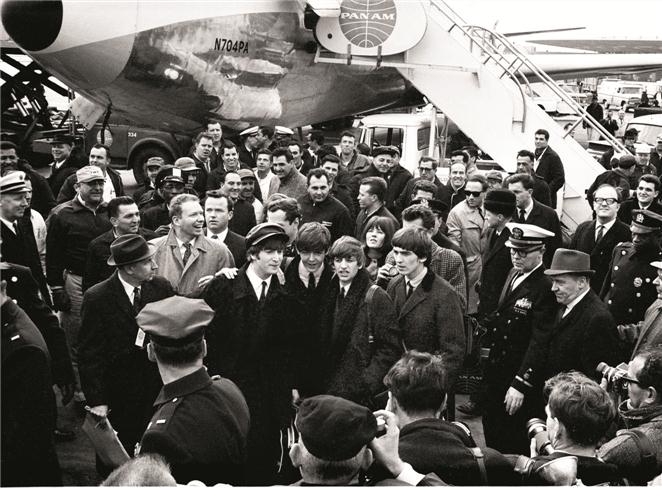On February 7, 1964, Pan Am Yankee Clipper flight 101 from London Heathrow lands at New York’s Kennedy Airport—and “Beatlemania” arrives. It was the first visit to the United States by the Beatles, a British rock-and-roll quartet that had just scored its first No. 1 U.S. hit six days before with “I Want to Hold Your Hand.” At Kennedy, the “Fab Four”—dressed in mod suits and sporting their trademark haircuts—were greeted by 3,000 screaming fans who caused a near riot when the boys stepped off their plane and onto American soil.
B y all accounts, The Beatles still had no idea what was in store for them on February 7, 1964, when they took off from London bound for American shores. Lennon remembered thinking, “Oh, we won’t make it,” while Starr recalled feeling “a bit sick” with anticipation. But when they touched down in New York, the group found themselves greeted by a flock of 3,000 ecstatic, screaming fans—many of them teens playing hooky from school. The band was stunned. “Seeing thousands of kids there to meet us made us realize just how popular we were there,” Harrison later said. In their first press conference, The Beatles appeared relaxed and upbeat. Clad in matching suits, the band fired back at the sea of reporters with cheeky quips that the New York Times later called the “Beatle wit.” “We have a message,” McCartney declared in between questions about the band’s name and their mop-top haircuts, “buy more Beatles records!”
y all accounts, The Beatles still had no idea what was in store for them on February 7, 1964, when they took off from London bound for American shores. Lennon remembered thinking, “Oh, we won’t make it,” while Starr recalled feeling “a bit sick” with anticipation. But when they touched down in New York, the group found themselves greeted by a flock of 3,000 ecstatic, screaming fans—many of them teens playing hooky from school. The band was stunned. “Seeing thousands of kids there to meet us made us realize just how popular we were there,” Harrison later said. In their first press conference, The Beatles appeared relaxed and upbeat. Clad in matching suits, the band fired back at the sea of reporters with cheeky quips that the New York Times later called the “Beatle wit.” “We have a message,” McCartney declared in between questions about the band’s name and their mop-top haircuts, “buy more Beatles records!”
 From the airport, The Beatles were each tucked into their own limousine and whisked away to the Plaza Hotel in Manhattan. Safe from the rabid fans camped out on the streets below, they spent the evening chatting on-air with local radio DJ Murray the K while the brothers Albert and David Maysles—the same filmmakers who later chronicled The Rolling Stones in the 1970 film “Gimme Shelter”—rolled camera for a documentary. The next day brought another round of interviews and photo sessions, but the band also squeezed in a sightseeing tour of New York. Ever the music aficionados, The Beatles insisted on passing through Harlem to catch a glimpse of the famed Apollo Theater.
From the airport, The Beatles were each tucked into their own limousine and whisked away to the Plaza Hotel in Manhattan. Safe from the rabid fans camped out on the streets below, they spent the evening chatting on-air with local radio DJ Murray the K while the brothers Albert and David Maysles—the same filmmakers who later chronicled The Rolling Stones in the 1970 film “Gimme Shelter”—rolled camera for a documentary. The next day brought another round of interviews and photo sessions, but the band also squeezed in a sightseeing tour of New York. Ever the music aficionados, The Beatles insisted on passing through Harlem to catch a glimpse of the famed Apollo Theater.
Two days later, Paul McCartney, age 21, Ringo Starr, 23, John Lennon, 23, and George Harrison, 20, made their first appearance on the Ed Sullivan Show, a popular television variety show. Although it was difficult to hear the performance over the screams of teenage girls in the studio audience, an estimated 73 million U.S. television viewers, or about 40 percent of the U.S. population, tuned in to watch. Sullivan immediately booked the Beatles for two more appearances that month. The group made their first public concert appearance in the United States on February 11 at the Coliseum in Washington, D.C., and 20,000 fans attended. The next day, they gave two back-to-back performances at New York’s Carnegie Hall, and police were forced to close off the streets around the venerable music hall because of fan hysteria. On February 22, the Beatles returned to England.

The Beatles’ first American tour left a major imprint in the nation’s cultural memory. With American youth poised to break away from the culturally rigid landscape of the 1950s, the Beatles, with their exuberant music and good-natured rebellion, were the perfect catalyst for the shift. Their singles and albums sold millions of records, and at one point in April 1964 all five best-selling U.S. singles were Beatles songs. By the time the Beatles first feature-film, A Hard Day’s Night, was released in August, Beatlemania was epidemic the world over. Later that month, the four boys from Liverpool returned to the United States for their second tour and played to sold-out arenas across the country.

